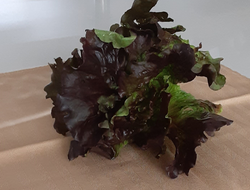Lettuce: What's in it for your health?
Published: April 29, 2021
Quick facts
Lettuce has been consumed raw and cooked for centuries.
As long ago as 50 AD the Romans served cooked lettuce dressed in oil and vinegar as well as serving young leaves as a pre-meal salad.
Today, for many people, a salad is not a salad unless it contains some type of lettuce or "salad greens".
Lettuce based salads are often at the core of weight loss diets and programs and have become associated with healthy eating practices.
Nutritional health recommendations highlight the benefits of consuming adequate amounts of vegetables.
What part does lettuce play, from a nutritional health perspective, in a healthy diet?
History
- Lettuce or Lactuca sativa is a member of the family Asteraceae commonly known as the aster or sunflower family.
- Lettuce is grown for culinary purposes throughout the world
- Mostly consumed raw as part of salads, sandwiches, and wraps
- May be served cooked: poached or in soups.
- Various types of lettuce are available:Iceberg lettuce, Romine lettuce, and Butterhead/Boston lettuce.
Nutrient content
A source of many vitamins and minerals such as vitamin A, potassium, vitamin C, calcium:
- Lettuce also provides small amounts of protein, carbohydrate, fat, and fibre
- Amount of nutrients depends on the quantity and type of lettuce you consume.
- Other salad ingredients may provide more of these nutrients and other nutrients.
- Iceberg lettuce, when compared to Romaine lettuce, provides approximately 50% of the same nutrients per 1 cup measure.
- You need to eat a lot of lettuce to obtain adequate amounts of nutrients.
- Lettuce is low in calories, but on its own lettuce does not provide sufficient nutrients for a well-balanced diet.
A balanced diet should include, depending on age and gender, 7-10 servings of vegetables and fruits. 1 cup of lettuce is equal to 1 serving of vegetables.
Contamination
A number of bacteria can survive on stored lettuce which have the potential to cause bacterial infections.
- Listeria monocytogenes, Campylobacter, Yersinia intermedia, and Yesinia kristensenii, E.coli 0157.H7, Salmonella, parasitic infestations, and viruses
- The amount of time that lettuce is stored at room temperature should be kept to a minimum.
- Store lettuce in your refrigerator and use within a day or two.
- Lettuce, and all leafy vegetables, should be washed in cold water to remove all dirt before consumption.
- Once a salad is prepared store the salad in your refrigerator until required.
- Make sure the vacuum seal on vacuum packaged lettuce is intact prior to opening. Once the packet is opened it should be stored in your refrigerator and used as soon as possible.
Lettuce can be substituted for spinach and Bok Choy in stir fries, added to soups, poached and braised.
As with spinach, lettuce cooks very quickly and reduces in quantity. 1/2 cup of cooked lettuce equals 1 serving of vegetables.
Link to the full article to fill in the gaps and learn more about lettuce and nutrition.
References
1.
Whitney, E. & Rady Rolfes, S. (2005). Understanding Nutrition. Belmont, CA: Thomson Wadsworth
2.

